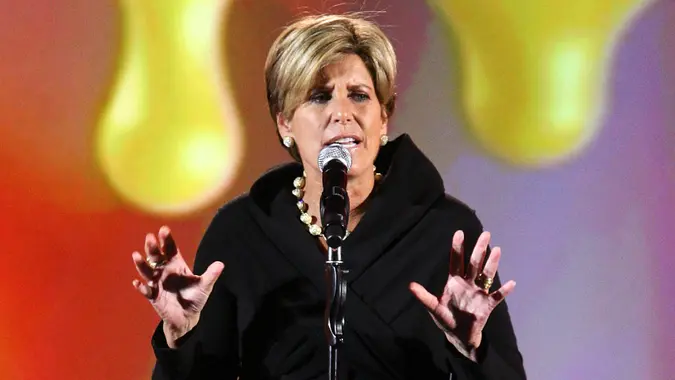GOBankingRates works with many financial advertisers to showcase their products and services to our audiences. These brands compensate us to advertise their products in ads across our site. This compensation may impact how and where products appear on this site. We are not a comparison-tool and these offers do not represent all available deposit, investment, loan or credit products.
A Look at Every Company That Pepsi Owns
Commitment to Our Readers
GOBankingRates' editorial team is committed to bringing you unbiased reviews and information. We use data-driven methodologies to evaluate financial products and services - our reviews and ratings are not influenced by advertisers. You can read more about our editorial guidelines and our products and services review methodology.
20 YearsHelping You Live Richer
Reviewed by Experts
Trusted by Millions of Readers
Food and beverage giant PepsiCo has been one of the world’s largest companies for decades. Second this year globally to only Nestle, PepsiCo is the largest food and beverage company in North America. PepsiCo, the larger conglomerate that is a result of decades of mergers, actually began as Pepsi-Cola in the 1890s and was founded by a pharmacist in North Carolina.
In the 1930s, it eventually expanded with Diet Pepsi and the purchase of Mountain Dew in the 1960s. Perhaps the largest acquisition that set the tone for the company to become a behemoth in the 21t century was the merger with Frito-Lay in 1965, when the company was founded as PepsiCo Inc, and the brand continued as we know it today.
From there, the company acquired beloved everyday brands like Quaker Oats, Gatorade, Fritos, Lay’s potato chips, Cheetos, Ruffles, Rold Gold pretzels and more, turning the humble late 19th century food company into an international billion dollar business.
Since its acquisition of Frito-Lay brands, PepsiCo has experienced tremendous growth, and has turned into one of the 66 “Dividend Aristocrats.” These are a select group of S&p 500 stocks that have provided at least 25 years or more of rising dividend payments each year to their shareholders.
The company has recently been in the headlines with news of its sale of juice company Tropicana. Changing diets and perceptions on sugar and fruit juice combined with lagging juice sales led Pepsi to scrap the household orange juice name, CNN reports. In the deal announced on Tuesday, PepsiCo’s juice business will be sold for roughly $3.3 billion to PAI Partners, with Pepsi retaining a 39% stake in the newly formed business.
Pepsi has instead chosen to focus on its zero calorie sports and energy drinks, along with its other healthier beverage options. Here is a look at PepsiCo’s new portfolio, and all the food and beverage brands it holds in its massive portfolio.
Last updated: Aug. 5, 2021
Lay’s
The Lay’s brand is one of the most recognizable throughout the world, and PepsiCo’s second most valuable brand behind only Pepsi itself. In 2017, Lay’s generated almost 2 billion in annual sales, with a market share of almost 30 percent of the entire potato chip market. Lay’s was created in 1932 by Herman Lay. He initially sold chips out of the trunk of his car and grew enough to merge with Fritos in the early ’60s to become Frito-Lay, before being acquired by PepsiCo in 1965.
Gatorade
Gatorade was famously invented by a team of scientists at the University of Florida for its Florida Gators athletes. The drink came front and center when the UF football team won the Orange Bowl two years later, Gatorade in hand. Gatorade has a 72% market share in sports drinks in the United States and is the only beverage athletes can drink courtside at NBA games besides water. The company was eventually bought by Quaker Oats in 1983.
Quaker Oats
Quaker Oats is a unique brand for Pepsi, as it is the only food brand the company has in its portfolios that is not a form of chip. Quaker Oats was formed in 1992 from the merger of four oat mills and purchased by PepsiCo for $13.4 billion in 2001. Although originally purchased to gain control of Gatorade, Quaker’s health-conscious image has paid off. As Western diets trend more towards healthier alternatives, the health-conscious oat producer balances the company’s Frito-Lay division.
Fritos
The deep-fried corn chip was created in 1932 by Charles Elmer Doolin, but the recipe was not entirely his own. Doolin found a vendor selling fried corn chips in San Antonio and asked them for the recipe. He then took it to his own kitchen and tweaked the recipe with his mother, and thus the Frito corn chip was born.
Get the latest news on investing, money, and more with our free newsletter.
By subscribing, you agree to our Terms of Use and Privacy Policy. Unsubscribe at any time.
You’re now subscribed to our newsletter. Check your inbox for more details.
Cheetos
Created by the same person that invented Fritos, Cheetos came to be in 1948. Charles Elmer Doolin did not have the means to nationally produce Cheetos, so he partnered with Lay’s. It was the success of Cheetos in the following years that led to the merger between the Frito and Lay corporations to become the modern conglomerate Frito-Lay.
Pepsi
The company’s namesake, Pepsi-Cola was actually first sold as “Brad’s Soda” as far back as 1893. The soda was created by Caleb Bradham in North Carolina, and in 1898, he renamed his soda Pepsi-Cola, coming from the digestive enzyme pepsin and the kola nut which was used in the original recipe. Pepsi is PepsiCo’s most valuable brand and is sold in over 200 countries with more than 20 billion dollars in revenue per year — but still comes in third after Coca-Cola and Diet Coke.
Diet Pepsi
Diet Pepsi was actually the first diet cola drink distributed nationally in the United States, released in 1964. Although its rival Diet Coke is also well-known, Diet Coke did not get released until 18 years later in 1982, making Diet Pepsi the original. Diet Pepsi has enjoyed massive success and has the seventh-highest soda market share in the United States.
Starbucks Ready To Drink
Ever seen a chilled Starbucks drink at your local gas station? That’s Pepsi’s doing. The two drink behemoths decided to partner up in 1994 to distribute ready-to-drink beverages in North America and then internationally in 2007. Although the business got off to a slow start, by 2012, Starbucks RTD beverages were bringing in more than a billion dollars per year in sales.
Aquafina
Aquafina was developed in-house by PepsiCo, and was released in 1994 to compete in the bottled water industry. Aquafina water is actually municipal tap water that is filtered using reverse osmosis, UV lights and ozone. It’s also one of the largest bottled water companies, behind only Dasani and private-label brands.
Lipton
Although PepsiCo does not own Lipton outright, the company distributes and sells Lipton’s ready-to-drink beverages in a partnership with Unilever — similar to their deal with Starbucks. The agreement began in 1991, and by 2011, the Lipton drinks had annual sales of over 2 billion dollars and are currently sold in over 100 markets throughout the world.
Brisk
Brisk is another Pepsi-Unilever partnership, where Pepsi does the distributing but does not own the brand outright. The brand reached over a billion dollars in sales in 2012, after increasing the can size and dropping the price to 99 cents to compete with Arizona and target a younger audience.
The U.S. tea market has quadrupled in 25 years, and this marks PepsiCo’s second billion-dollar tea brand on its roster.
Pepsi Max (now Pepsi Zero Sugar)
The supposed male-targeted answer to Diet Pepsi, Pepsi Max was a diet soda “for men.” Thinking that most diet soda drinkers are female, Pepsi Max is a zero-calorie diet drink marketed directly towards male audiences. It was released in 1994 in the UK and Italy and quickly spread thereafter.
Ruffles
The potato chip with the ruffles has been around since 1958. The chip ridges help to keep the structure of the chip in the bag and break less. This also helps it to carry more dip and adds to its crunch. The brand generated around $2.5 billion dollars in sales the last time PepsiCo released individual sales data for brands in 2011.
Doritos
Doritos are PepsiCo’s second most valuable chip brand behind Lay’s. Doritos were invented at Disneyland in California in the early ’60s. In 1964, an executive at Frito-Lay realized how popular the chip was at Disneyland, and decided to make a deal. For the first time, Doritos were taken out of Disneyland and, in the early ’90s, broke a billion dollars in sales.
Soda Stream
We have all seen a Soda Stream or copycat in recent years. The Soda Stream system is the kitchen tabletop device that turns any water into a carbonated beverage with the click of a button. It was acquired by PepsiCo in 2015 for $3.2 billion , and is the company’s attempt at targeting a growing consumer segment that is more health and environmentally conscious. Soda Stream also inevitably reduces the use of plastic bottles.
Sierra Mist
Sierra Mist is the Sprite of PepsiCo. The lemon-lime carbonated soda was introduce in 1999, and has been free of artificial sweeteners since 2010. The soda is instead sweetened with sugar and stevia.
7 Up
Although Pepsi owns the international rights to 7 Up, it does not own the right to the company in the United States. The drink was invented in 1929, and although it changed hands a number of times (including with cigarette company Phillip Morris) the U.S./Canadian rights to the company are owned by Dr. Pepper/Snapple.
Mountain Dew
The green carbonated drink is the second most popular beverage brand behind Pepsi itself. Mountain Dew has brought in billions of dollars in sales and has the fourth highest market share in the United States soda market behind only Coca-Cola, Pepsi and Diet Coke. The drink was created in 1940 in Tennessee.
Diet Mountain Dew
Originally branded “Sugar-Free Mountain Dew”, the diet version of the original was released in 1986, and as of 2011, reached a billion dollars in annual sales.
Mirinda
Mirinda was created in Spain in 1959, and acquired by PepsiCo in 1970. Never seen it? Think of a Fanta, which is the brand’s closest competitor. Miranda is popular in Europe and the Middle East.
Walkers
Walkers is simply Lay’s, but with a different name for consumers in the UK and Ireland.
Photo Disclaimer: Please note photos are for representational purposes only.
Share this article:
You May Also Like

Suze Orman: This Uncommon Approach To Building Wealth Could Change Everything If You're Sick of Low Returns
December 19, 2024
10 min Read

9 Income Streams You Can Build While Still an Employee, According to Codie Sanchez
December 18, 2024
10 min Read





5 Key Signs You Need To Break Up With Your Financial Advisor and How To Do It
December 17, 2024
10 min Read


6 Great American Suburbs Where You Need a Salary of $300K To Live Comfortably
December 19, 2024
10 min Read

5 Rules Every Rich Person Uses To Make Money, According To Money Expert Ramit Sethi
December 18, 2024
10 min Read


7 Reasons It Seems Like Everyone Has More Money Than You, According to Humphrey Yang
December 17, 2024
10 min Read


Get the latest news on investing, money, and more with our free newsletter.
By subscribing, you agree to our Terms of Use and Privacy Policy. Unsubscribe at any time.
You're now subscribed to our newsletter.
Check your inbox for more details.
Banking Offers
Sending you timely financial stories that you can bank on.
Sign up for our daily newsletter for the latest financial news and trending topics.
For our full Privacy Policy, click here.
Looks like you're using an adblocker
Please disable your adblocker to enjoy the optimal web experience and access the quality content you appreciate from GOBankingRates.
- AdBlock / uBlock / Brave
- Click the ad blocker extension icon to the right of the address bar
- Disable on this site
- Refresh the page
- Firefox / Edge / DuckDuckGo
- Click on the icon to the left of the address bar
- Disable Tracking Protection
- Refresh the page
- Ghostery
- Click the blue ghost icon to the right of the address bar
- Disable Ad-Blocking, Anti-Tracking, and Never-Consent
- Refresh the page

